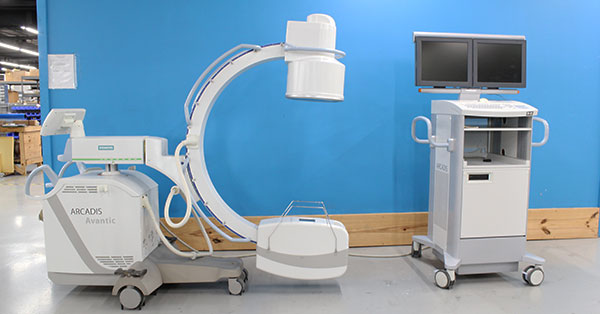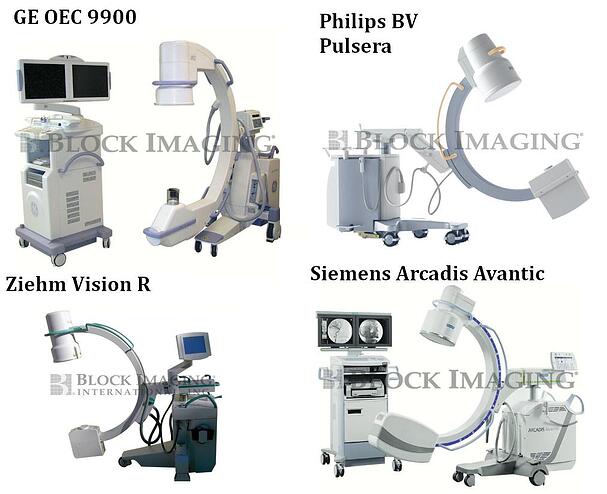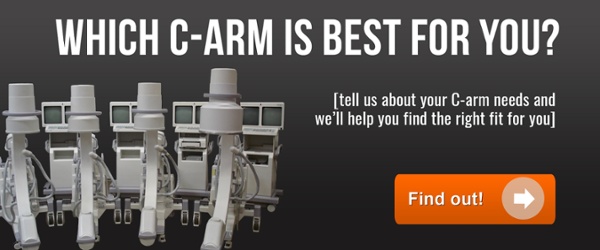
You’ve shopped around. You’ve heard the sales pitches and perused the slick brochures with images of earnest-looking doctors and doe-eyed nurses. And yet, your thirst for C-arm knowledge is not quenched. No. You’re still left with a single burning conundrum: Power!
To answer this question, we took four leading C-arms currently on the used imaging equipment market to task. At the end of our research, a decisive winner emerged. Read on to find out what we learned.
Which Used C-Arm Has the Most Power?
Before we begin, let us introduce the four C-arm models we considered for this comparison.

The Criteria
Now, when the sheer power of a used C-arm comes into consideration you’ll want to know a few things up front:
- How much total power can it generate?
Penetration power is a key feature to consider in a C-arm. For the orthopedic or pain doctor it will come into play while taking lateral abdomen or spine shots on large or obese patients. Without the proper power the image you take will be too dark. Dark images can be lightened up using post processing features on your C-arm, but often times it will be too grainy and may require you to take several shots. For invasive vascular surgery you want the ability to do lateral abdomen shots, angiograms, and run offs.
- How is that power partitioned?
All four of the above units have pulsed fluoro for reduced dose to the patient. It’s important to note that more power doesn’t necessarily mean more radiation for the patient. All of these units adhere to FDA safety regulations for dose. Be certain that your system is within proper calibration, dose has been measured by a physicist or engineer, and that you are using proper techniques to avoid excess radiation.
- How hard and how long can I push the x-ray tube?
All four of these systems have rotating anodes, and that’s a good start. Rotating anodes have a higher heat capacity than fixed anode because the tube is actually rotating either in oil or water to keep it from overheating.
The Specs
Power is measured in several categories and it can get very technical. We have chosen to highlight and address just 5 separate categories – see below – to give a general idea.
|
Feature |
OEC 9900 |
Philips BV Pulsera |
Ziehm Vision R |
Siemens Arcadis Avantic |
| Generator |
15 kW |
7.5 kW |
7.5 kW |
25 kW |
|
kV Range |
50-120 |
60 Fitted |
50-120 |
40-125 |
| mA Range |
Up to 75@120 kVp |
3.25-125 |
Up to 75@110kVp |
Up to 250 |
|
Tube Power Rating |
15kW@100kVp |
15kW@110kVp |
15kW@100kVp |
25kW@100kVp |
|
X-Ray Tube |
Rotating Anode |
Rotating Anode |
Rotating Anode |
Rotating Anode |
|
Heat Capacity |
300,000 HU |
30,000 HU |
300 KHU |
270,000 HU up to 2,500,000 HU housing |
The Results
We’re not here to knock our other contenders. They all sport other great features, but when it comes to raw power the clear standout winner is the Siemens Arcadis Avantic (insert thunderous applause). This unit’s 25kW high-frequency generator is almost twice the size of the next largest GE OEC 9800. Its mA range, kV, and heat capacity are also a clean sweep.
For our money, if you’re looking to power through thick anatomy and still get bright, clear images, you should definitely look into trying out a Siemens Arcadis Avantic. Congratulations, Avantic! We’d give you a statuette, but you don’t have hands.

Chris Sharrock
Chris Sharrock is the Vice President of Healthcare Solutions at Block Imaging. Each day Chris sets out to provide the best equipment, parts, and service solutions for healthcare facilities across the world. Outside of work Chris enjoys playing in a band, and spending time at the lake with his family.





